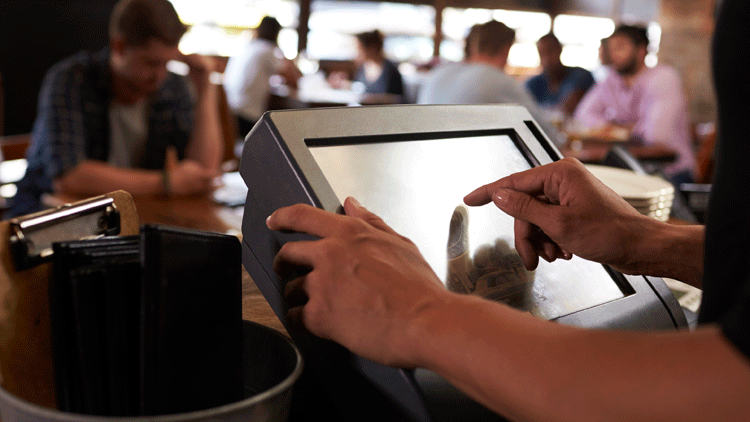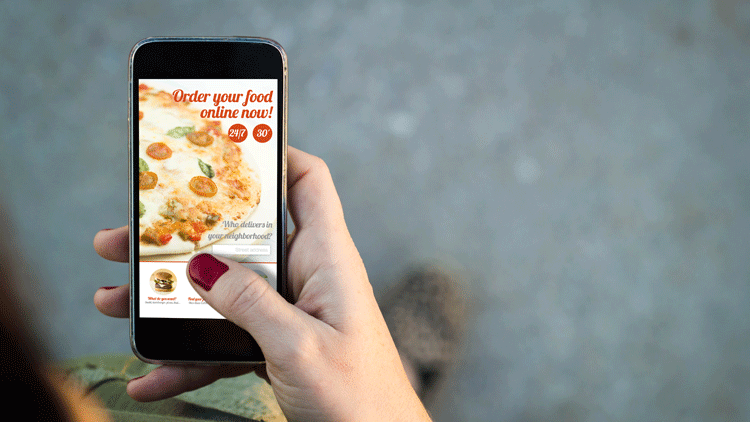Talking tech: the systems that will shape the restaurants of the future

What does the restaurant of the future look like? According to a new report by Oracle Hospitality called Restaurant 2025, robots could be cleaning restaurants and making French fries, regular customers could be identified through biometrics and facial recognition, and take-out food could be delivered via drones.
The report was produced after surveying 250 restaurant operators and their customers, who were asked for their predictions on the take up and usability of artificial intelligence, biometrics/facial recognition/3D imaging, robotics, voice activation, wearable technology, virtual reality, drones and 3D printing. All are deemed to have some kind of place in the hospitality sector of the future, with 54% of operators saying that gathering guest feedback by voice would be mainstream or in mass adoption by 2025, and 66% believing guests paying by wearable technology would be mainstream or in mass adoption by 2025.
Nearly 50% of customers surveyed said that being recognised without a loyalty card or giving a name – thanks to facial recognition technology – would improve the guest experience, with 31% saying they would visit a restaurant more often if this were the case. And 47% of operators believed that robot cleaning would be mainstream or in mass adoption by 2025, with other predicted uses for robots including kitchen prep and staff training.
If all that sounds a bit far fetched, there are other technological developments that the industry is likely to embrace in the nearer future. And the key driver of this technological advancement is likely to be the ever-more sophisticated EPoS systems that are currently under development.
Managing cash
Leading supplier Tevalis, for example, has just launched a cash management tool that sits alongside its cloud-based suite of enterprise modules. This intelligent module enables users to manage all cash on site in an efficient and seamless manner, it says, by absorbing all data from the PoS including Z Reports. Users can then go on to process their banking through a cash up wizard tool, eliminating issues that occur when manually calculating cash on site.
With the ability to view what money the business is down on in the summary variance section and in what asset, the problematic ‘missing money’ issue that waiting staff and management often come across can easily be resolved in a matter of minutes.
The growth of mobile technology has had a major impact on the EPoS arena and that’s set to continue, with suppliers offering more and more functionality via mobile devices. “Mobile ordering and payment have quickly become mainstream and are set to grow,” says Zonal sales and marketing director Clive Consterdine, who cites a CGA Peach report it worked on that says that in less than two years the number of consumers who use mobile devices to speed up payment has increased from 2.4m to 3.1m.
"Nearly 50% of customers surveyed
said facial recognition technology
would improve the guest experience"
“It’s also a very effective tool in terms of driving additional orders from each customer, with 67% of 25 to 34 year-olds saying they would spend more and buy more drinks if they could order from their smartphones rather than queue at the bar or wait for table service,” adds Consterdine. “When it comes to upselling, recommendations from a waiter can seem scripted and pushy, but when a product is suggested in an app it’s viewed as helpful and part of the service, enhancing the customer experience.”
Mobile ordering demand
Tevalis commercial manager Samantha Weller shares this viewpoint. “There’s now more of a requirement for mobile ordering technology due to the enhanced customer satisfaction it generates,” she says. “With Tevalis, customers can pay at their tables using a code generated on the app, whether paying for specific items or splitting the bill. Users can also simply order through the app and monitor their spend throughout the visit, all with the touch of a button on a smartphone.”
Comtrex also offers payment via smartphone and believes the days of chip and pin are numbered. “Gone are the days of magnetic strips and signing, and chip and pin are going the same way,” says Comtrex’s sales manager Clive Keywood. “Smartphone payment – with apps like MasterCard’s Qkr! – is the future.”
Comtrex has partnered with MasterCard and its Qkr! app/digital wallet as used at ASK Italian and Zizzi. This integration enables customers to view, split, add gratuity and pay the bill via the app and soon customers will be able to order directly from the kitchen, says the EPoS supplier.
It was the huge growth of mobile technology that prompted Pizza Express to introduce a fully integrated online and telephone table reservation system last year. The liveRES system from Zonal means bookings can be made in any of the pizza chain’s restaurants 24 hours a day, with telephone bookings being automatically handled if staff aren’t available to answer a call.
“In the hospitality industry, it is important to make sure all channels have the same availability, so a premium service is available no matter how the customer would like to book,” says Pizza Express IT director Siobhán Fagan. “This fully integrated solution has given us the opportunity to ensure the bookings journey is as slick and customer-friendly as possible, and we have seen an increase in bookings already.”
Another key objective for the chain when introducing its integrated reservation system was to receive insights into customers’ booking behaviours and needs. LiveRES statistics and integration into the till system gives Pizza Express the ability to analyse the entire customer journey from booking a table and ordering a meal to paying the bill.
The past few years have seen huge growth in the use of cloud solutions that offer operators the benefits of a monthly rental model rather than a large upfront cost. With a cloud a third party takes responsibility for the infrastructure, storage, operating system and virus checking, minimising in-house IT costs.
In addition to liveRES at Pizza Express, the cloud-based analytics platform IOVOX gives the company access to and ownership of its booking statistics, giving it the power to analyse over-the-phone reservation trends over time. “Through these analytics we can track the customer journey, measuring demand and booking trends such as group sizes and busy periods,” says Fagan. “This helps with forward planning, and to identify problem areas to adjust.”
Fagan is already using the data to introduce tailored and early access to customer offers as well as giving early visibility of menu changes. “Working with liveRES and IOVOX, we will not only continue to deliver on our commitment to offer the ultimate customer service today, but we will gain significant intelligence-led customer insights that will enable us to further improve the customer experience of the future.”
Other companies are also tapping into the potential of cloud-based services. Oracle Hospitality has just launched two data science cloud services aimed at enabling operators to analyse key information such as sales, guest numbers, marketing effectiveness and staff performance data at speed.
Oracle’s Menu Recommendations cloud service allows operators with multiple locations to evaluate their menus and identify enhancements to maximise every sales opportunity. The data science service can seek the best possible up-sell or cross-sell options by location or time of day, with recommendations updated based on real-time customer behaviour. Recommendations are available at point-of-service terminals and displayed as localised cross-sells or timed up-sells.
Oracle’s Adaptive Forecasts cloud service, meanwhile, enables operators to better predict stock and labour needs at every location. The service creates a single forecast by item, location and day part, and factors in weather, events, time of day, day of the week and net promoter scores.
“A key benefit of modern cloud-based systems is that reports are available in real-time, which significantly enhances the quality of restaurant operators’ decision-making and future planning, in areas such as stock and inventory, staff management and margin control,” says CBE Software international product manager Kevin Greene.
“However, it’s crucial operators don’t abuse this power and lose staff trust.” Greene suggests restaurants use the data to establish and reward those members of the front-of-house team who are performing well, for example.
With many restaurants steering away from the traditional model towards serving their customers in alternative ways, technology is evolving to keep pace.
As Richard Goodall, vice-president for Hospitality EMEA at NCR, says: “There is now a massive focus on foodservice providers to operate across multiple channels, including online ordering, kiosks and drive-thrus, as well as the traditional in-store experience. Consumers want the ability to purchase in the most convenient and simple way for them at any particular given time.”
"The past few years have
seen huge growth in the
use of cloud solutions"
Certainly, self-service kiosks have been a key development focus for Tevalis, with the company believing that demand in this area will continue to grow at pace. “For many venues, self-service kiosks are the answer to improving speed of service, reducing queue times and improved utilisation of labour through staff positioning,” says the company’s Samantha Weller.
Tevalis’ latest customer in this arena is expanding chain Sticky Sisters, operated by Burger King franchiser Karali Group. The chain, which specialises in chicken wings served with a variety of sauces, and milkshakes, has sites in Leeds and Farnborough, Hampshire, with a third due to open soon in Harlow, Essex.
“With customer satisfaction being at the heart of the business, the owners wanted to ensure they enhanced their dining experience with their technology solutions,” adds Weller. “On that basis, both sites now have Tevalis self-service kiosks, enabling customers to go on a seamless ordering journey and putting more choice into their hands.
“Sticky Sisters now has a branded solution that offers advantages such as fast speed of service, ease of usability, fully tailored functionalities alongside the ability to reduce their labour costs and drive profit margins on a long-term basis.”
Another major area of development for Tevalis over the past 18 months has been the creation of an innovative EPoS app for operators that want to capture important data on the go. “We felt there was a gap in the market for this, so the Tevalis Enterprise Epos Mobile (TEEM) does exactly that and is available to all of our clients,” says Weller. “Not only does TEEM provide a summary of real-time business data, but it also gives the user full access to reports such as sales, service, security and cash-up information.
“Users can also set up alert thresholds to be notified on certain activities that they believe are essential to monitor. It’s an ideal solution for all operators, including those who are away from their site but want insight as to how their business is operating in real time.”
Meeting growing demand
With so much innovation in the category, a growing demand from restaurateurs is that the various technologies on the market can be integrated to work with each other. This, says CBE’s Greene, is something that the industry has worked hard on in recent years.
“With restaurant operators under increased pressure due to rises in the national living wage, rent, business rates and food prices, there is an ever-increasing opportunity for technology to drive greater efficiencies and elevate customer service within the sector. However, with technology continuing to evolve at such a significant pace, suppliers need to stay ahead of the curve, by regularly developing their offerings to deliver a holistic, smart solution for restaurant operators.
“Ultimately, an EPoS system is not capable of being everything to everyone. However, when you consider the fact that a multi-site operator relies, on average, on seven to eight solutions for the smooth running of their restaurant, it’s essential that the EPoS system has the capacity to integrate.”
Flypay’s Tom Weaver also believes that integration holds the key to future success for operators. “Today, the leading restaurant operators want to get ahead of the game, but do it in such a way that is unique to them,” he says. “They want to leverage all the work that has gone in before to build out these solutions, while also finding their own competitive advantage.
“Ultimately, what they really want is for the technologies they already use to form different parts of the customer journey, to work together to improve consumer and staff experiences. The good news is that the best technology companies are working together in ground-breaking new ways to make this happen – collaborating, not competing.”
Flypay is managing this integration and configuration through its Flyt ordering platform, which Weaver compares to “laying digital railway tracks” for the restaurant operator. “There are various types of trains that can run over the rails, for example, to deliver new orders directly into the PoS. We have been collaborating with delivery and ordering companies to enable this, removing the need to rely on tablets.
“Other trains want to extract data from the PoS for use in other areas of the business, such as table management systems, insight and analytic tools, CRM and a number of apps and consumer-facing services. So, rather than all parties carrying out the same integrations company by company, which slows down the provider and the tech company, this can be achieved through one platform in order to speed up the process.”
Greene points out that CBE software currently integrates with more than 200 partners for functions including payments, mobile ordering, loyalty, online ordering, kitchen automation and queue management. It is through better integration that EPoS suppliers can remove the barriers to expansion for operators, while setting a precedent for competitors in the hospitality space.
“In order to remain a step ahead, restaurant operators should look to work on a collective, open platform with a PoS partner willing to adapt to change, adopt new technologies and ultimately, grow with your business, as times change,” says Greene. “Now that is a future-proof system.”
This is a web version of an article that first appeared in the September issue of Restaurant magazine, the leading title for the UK's restaurant industry. For more features, comment, interviews and in-depth analysis of the restaurant sector subscribe to Restaurant magazine here.











